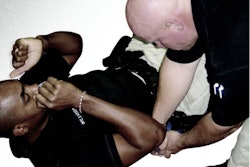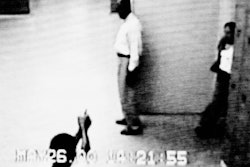The looters hit the gun stores in New Orleans first, loading up with rifles and ammunition to better fend for the crimes to follow. Then they descended upon other stores. Before long, they moved from the business districts to nearby residences. And what Hurricane Katrina hadn't ravaged or left destroyed, they did.
In response, a type of neighborhood watch developed overnight. Armed hurricane holdouts patrolled the streets protecting their own houses and those of evacuees.
Some New Orleans residents wondered why the National Guard did not show more initiative in stopping looters. Others put the blame on local law enforcement personnel. More enlightened souls recognized that many local officers and their families were among the victims. Police officers who remained on duty were shot at. Some simply tossed in their badges. Two committed suicide.
Perhaps more than anything, those two suicides illustrate how helpless and even hopeless some law enforcement officers can feel when confronted with mass looting. When looting breaks out, it seems like nothing can be done to restore order. But that's not necessarily true.
Desperate Hours
A quick police response is the most effective weapon against mass looting.
"Looting is basically crime that breeds itself," explains Commander Sid Heal of the Los Angeles County Sheriff's Department. "The first hours of an incident are critical. A timid or delayed response sends an implicit message: We are either unwilling or unable to stop the situation. A single window smash can be a precursor to hundreds. When people see somebody get away with a brazen crime, they conclude, 'Well, if they can do it, so can I.' And the cycle continues."
Unfortunately, law enforcement faces a conundrum when it comes to the prospect of dealing with looters: If we use force and show an assertive law enforcement presence, will we later be accused of escalating the situation? If we don't, will we be prepared to deal with accusations of ineptitude and cowardice by business owners and residents for not acting to save their property?
It's pretty common for some officers to assume that an agency's indecisiveness in the face of such diabolical choices is a result of administrative cowardice. But Richard Odenthal, a retired law enforcement veteran who trains on civil disorder management, believes the situation is more complicated than that.
"First, you need to have a clear-cut mission," Odenthal explains, saying that everyone needs to know what they are trying to accomplish and how they are going to do it. "Next, you have to have sufficient training, personnel, and logistics to carry out that mission. Finally, you have to have administrators who will stand by the mission that they developed. From the very top on down, everyone has to be on the same page. If you don't have that kind of commitment up and down the food chain, people will be hesitant to carry out their missions."
Deadly Exaggerations
Lee Clarke, a professor at Rutgers University and the author of "Worst Cases, A History of Disasters," says the biggest factor in a police agency's ability to prevent or quell looting is having a general knowledge of how people respond to disasters.
"The chief thing to remember is that the problem is almost never as extensive as it is reported. The situation in New Orleans is a prime example," says Clarke. "We now know that the reports of widespread killing and raping were gross exaggerations. The major issue of looting coverage is that it is often a better barometer of the intensity of media interest than it is of any actual instances of looting."
Like most serious incidents, the best way to handle looting is with plans developed to combat it in advance of the incident that triggered it. Unfortunately, when all hell is breaking loose on the streets, plans change in a hurry.
"Having a plan is essential," adds Odenthal. "But no single plan can cover all possible contingencies. A plan should be structured enough so as to make sure that everyone has a clear mission, but flexible enough to allow for situational variances."
Also, like any battle, the decisive factor in a police agency's attempt to quell looting is for the hearts and minds of the people. It's a battle that's won or lost long before looting breaks out.
"The other important component that must be established, long before any disaster, is institutional trust," says Clarke. "Local law enforcement needs to be truly integrated into the community to enjoy a degree of reciprocal trust. In those areas where law enforcement is well regarded, law-abiding citizens are more likely to step up to the plate and help police officers in their hour of need."[PAGEBREAK]
A Matter of Magnitude
Dennis Beene, a Region 6 law enforcement coordinator with California's Office of Emergency Services, notes that much of what happens during a riot is very similar to what is routinely handled by law enforcement personnel, just at a monolithic scale.
"Traffic control, crowd control, evacuations, we do these things routinely in response to fires, floods, and other phenomena. But with looters we have an added dynamic of a moving problem," Beene says.
Sid Heal characterizes the fluid dynamics of combating looting as plowing water. "You succeed in pushing something aside, only to see it flooding back behind you in the rearview mirror," he explains.
Everything at Once
Cops faced with looters can be as busy as the proverbial one-legged man at a butt-kicking contest. However, they have to persevere or things will just get worse.
"There can be some arguable priority to your concerns," Odenthal acknowledges. "But ideally, you need to do certain things simultaneously. First, establish a containment while sizing up the problem. Determine what exactly the nature of the problem is, as well as the size of the affected area. What is the number of people involved? Or that stand to be involved?"
The next priority and one of the most crucial is to call for help if you need it. Agencies facing widespread looting have to be willing to swallow a little bit of their pride and ask for help.
Beene, a law enforcement veteran whose career includes first-hand experience with multiple riots, says that it's frustrating that more agencies don't have established protocols in place to take advantage of available interagency assistance.
"Unfortunately, many agencies still don't have mutual aid agreements," Beene says. "Even Oklahoma doesn't have one, despite the Oklahoma City bombing of 1995. Some jurisdictions have a 'y'all come' mentality, leaving things to improvised coordination. You need to have clear-cut missions and people designated to carry them out."
Even when law enforcement brethren from other agencies rolled from considerable distances at great personal risk to assist in the wake of Hurricane Katrina, many were effectively told to stand down. The lack of planning and coordination for mutual aid meant that desperately needed law enforcement resources could not be deployed.
Murphy Reigns Supreme
Effective looting response can include the implementation of curfews, executing mass arrests or displacing subjects to other sectors, and making key targets much less attractive to looters.
Beene offers an example of how the allocation of police resources and implementation of policies can change very rapidly during a looting incident.
"The city of Hawthorne, Calif., had a brand new strip mall opened just prior to the Rodney King riots kicking off," Beene says. "Initially, there was consideration given to letting suspects steal, so long as they did not destroy the architecture. But that posture was quickly reevaluated. Instead, the decision was made to make it as difficult as possible for people to even come close to the mall. Effectively, it was locked down.
"A similar decision was made regarding the Fox Hills Mall in Culver City," Beene says. "Some 50 officers from seven different police departments were deployed on site. Some were given rooftop assignments, others foot beats, while still others patrolled around the mall in their patrol cars. Basically, their mission was to baby-sit the location. It wasn't a romantic one, but unlike many other locations, the mall was spared."
Beene says venues that generate a lot of revenue are among the most likely candidates for hard targets. But he adds, "The most coveted and dangerous targets are gun stores. Not only do you then have the immediate problem of looting, but long-term collateral concerns of what the suspect will be using those guns for thereafter," he explains. "If you're looking over your shoulder for armed cadres of looters, you're compromising your ability to bring things under control as quickly and as effectively as possible."[PAGEBREAK]
Looting in Progress
Should looting break out, establishing containment and control become your primary missions.
"If a looting incident has occurred, then you need to isolate the problem," Odenthal says. "There should be a two-pronged approach. You need to arrest major offenders and make sure that you have some measure of televised accountability. Because if the only images being absorbed by your public are of people carrying off television sets with impunity, you can rest assured that you will have more of the same."
Odenthal makes this emphatic point about police response. "Your most powerful tool is the arrest," he says. "It has an immediate impact, as it communicates to the public that there are prices to be paid for the violation of society's laws. It also shows the public that you are being proactive on their behalf.
"This is one of the reasons why Sheriff Sherman Block (Los Angeles County) made sure that the news media rode along with our field forces when they were rounding up looters [during the Rodney King riots]," Odenthal says. "He wanted people to know what would happen to them if they were caught looting."
Another way to help turn the tide against looters is to get the media on your side. Odenthal says this was critically important during the Rodney King riots. "Within the first 24 hours, the media saw themselves as fast becoming victims in what they were chronicling, and few could be found entrenched in either the 'detached air' or sympathizers camps. After their news vans had been vandalized and some of their own had been robbed and assaulted, more than a few were only too happy to assist us in this mission."
Odenthal is a realist. He recognizes that even in the best of circumstances, law enforcement personnel may find themselves seriously outnumbered.
"In such circumstances, the focus should be on removing disruptive influences and establishing sector-by-sector control. If you simply do not have sufficient means to effect arrests, then at least consider video documentation of any looting. In the aftermath of the 1985 Huntington Beach riots, video documentation proved invaluable in prosecuting those responsible for damages," Odenthal says.
Restoring Calm
Whether a looting incident has been prevented or quelled, policies and procedures have to be in place to allow for the safe re-entry of business owners and residents to the affected area. This may entail a lengthy process, particularly in those instances wherein displaced owners have traveled hundreds of miles away from their homes.
"You have to protect the area against the potential for crime," Odenthal says. "You can't just open the gates and let people in. Your plan has to allow for the reoccupation of the area in an orderly manner. This will almost always entail some degree of checkpoints and passes. This will help you ensure that you're not letting criminals back in."
Odenthal adds one important point. "You need to be able to 'envision the end.' You need to picture what the end result of all your planning and execution has gotten you, and how life will be thereafter. This will help you understand where you need to get to and what you need to get there. Finally, it will let you recognize when you have succeeded in getting there."
This is an important consideration. "At one point during the East Los Angeles riots, we were on our 10th day standing on the streets," Odenthal recalls. "There wasn't even a curfew, but there was absolutely nobody out and about. Actual problems had long since dissipated, but we were still out there. It got to the point where we really felt like we were an occupying army. There was simply nothing for us to do."
Responding to Looting
- Have a plan
- Set up mutual-aid agreements
- Coordinate mutual aid as needed
- Respond quickly
- Show force
- Know your mission
- Know who is looting
- Know what triggered the looting
- Know where the looting is happening
- Establish containment
- Harden key targets
- Make arrests
- Seek media coverage of arrests
- Document looters on video for future prosecution
- Guard area until peace is restored
A Logistics Nightmare
Since looting often strikes a population like some mass hysteria, it can be extremely taxing on an agency's, or even on multiple agencies', resources. For example, in the aftermath of Katrina, the New Orleans Police Department and the Orleans Parish Sheriff's Department had to use makeshift jails as holding centers for suspects charged with looting. The official jail buildings were flooded.
What to do with arrested looters is an especially difficult problem for many agencies after major disasters or during civil disturbances. "You have to ask yourself, do you have the resources to arrest looters?" says Commander Sid Heal of the Los Angeles County Sheriff's Department.
The question of whether to arrest looters is a critical logistics issue not just in terms of what to do with the prisoners, but also in terms of street resources. In other words, a couple of officers facing down a mob works great in the movies but on the street, not so much.
"If you think about the most obvious logistics deployed to a civil disturbance, it's often about three or four radio cars, each containing three to four officers," says Heal. "When these officers arrive at a problem location, they need to know the rules of engagement and have a clear-cut mission. The rules become more pressing as the numbers of looters grow. Can you effectively face a huge crowd, let alone arrest its participants?"

















